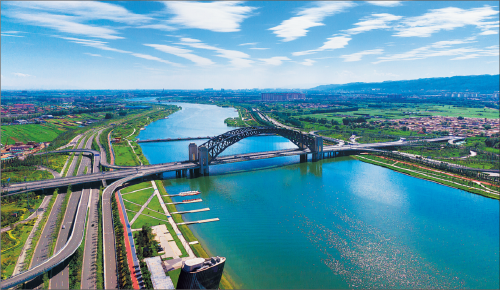Shanxi's environment delivers the feel-good factor
Updated: 2023-01-28

The Fenhe River runs through Taiyuan, Shanxi province, adding luster to the city's landscape. WANG JING/FOR CHINA DAILY
Province's air and water quality registers a record improvement in 2022
Pictures of blue skies dotted with white clouds, and rivers and lakes with clear waters were a hit on social media in the North China province of Shanxi on New Year's Day.
Guo Lilan, a resident of Taiyuan, the capital of Shanxi, had a walk along Fenhe Park in the city that day. The park is part of a scenic belt along the Fenhe, the second-largest river in the province.
"To be bathed in the warm winter sunshine and to see the crystal-clear water in the river can always put people in a good mood," Guo said.
She added that these pleasant days are no more unusual as they were years ago. "But as the environment is improving, I can tell you this New Year's Day is the best in my memory and you can expect even better days in the future."
Guo's feeling was supported by the latest environmental data. The Shanxi Department of Ecology and Environment announced on Jan 2 that the province achieved breakthroughs in both air and water quality in 2022, with several indexes reporting their best in history.
For instance, it said the comprehensive air quality index was 4.49, improving 2.4 percent from 2021.The improvement rate was 31.7 percent over the past five years.
About 74.5 percent of the days in 2022 maintained good or excellent air quality, representing a 2.4 percent improvement from 2021.
The monitoring stations of Shanxi's surface water bodies showed that 86 percent of the monitored sections reached good or excellent level in 2022, increasing 13.7 percentage points from 2021 and 30.8 percentage points from 2017.
The remarkable improvements are a result of the concerted efforts of governments, businesses and residents, the department's officials said.
The provincial government of Shanxi released an action plan for improving the air quality over 2022-23, requiring local environmental protection departments in Taiyuan and another 30 counties and cities in its neighborhood to halt the approval of polluting industrial projects like coking facilities and conventional steelmaking furnaces.
Local businesses had implemented strict pollution control measures before this ban. Shanxi Guangda Coking and Gas Resources based in the county of Xiangfen, for instance, was the first coking enterprise in the country to release a corporate emission standard, which was stricter than the national standard, in 2020.
According to Wang Junliang, deputy general manager of Guangda, the company has installed multiple monitoring devices for the emission of polluting gases and volatile organic compounds.
"If emissions surpassed our standard, the monitoring system will report the emission data and the location to the operations center and a halt of operations at the location will follow," Wang said. "The operation can resume only after the problems (that caused abnormal emissions) are identified and solved."
Taiyuan Iron and Steel Group is another example of a company reducing its waste gas, wastewater and solid waste discharges.
According to Shi Lairun, an executive responsible for environmental protection at the company, the discharge reductions are made possible with its wide-ranging recycling practices.
At the group's coal-fired power plant, for instance, the coal ash and other solid waste are recycled to make bricks and other prefabricated construction components.
"Apart from solid waste recycling, we are also making the maximum use of other wastes," Shi said. "The exhaust gases are turned into fuel for power generation, the surplus heat is used at heating plants, and the wastewater is disposed to be reused in the production process."
The corporate efforts have led to decreases in almost all kinds of air pollutants, according to the Shanxi Department of Ecology and Environment.
Its statistics show that 2022 saw the concentration of PM2.5 — particular matters with a diameter of 2.5 micrometers or less — decrease by 2.6 percent from 2021. Discharges of sulfur dioxide and carbon monoxide also dropped by 20 percent and 6.7 percent respectively.
The Fenhe River is a prime example of Shanxi's efforts to improve water quality. The provincial department of ecology and environment's recently released data show that 57.1 percent of the river's water body reached good or excellent water quality level in 2022, growing 9.5 percentage points from 2021.
With sustained efforts in controlling pollution, repairing ecology and increasing water supply, the river's ecological system is expected to improve in the years to come, according to Wang Yanfeng, head of the department.
The official predicted that 80 percent of the river's water body could reach a Class III water quality standard by the end of the year. Class III refers to water that can be used for irrigation and aquaculture.
He also predicted that the entire river could reach Class III by the end of 2024 and surpass the standard by the end of 2025.
Wu Jia contributed to this story.



